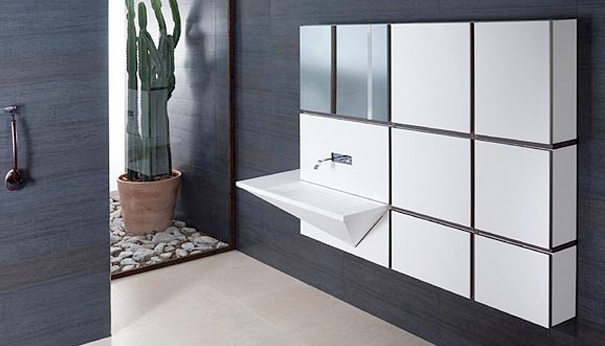Mondart Masters the Modular Bathroom Unit
The ceramic tile behemoth known as Porcelanosa is branching out. Established in the early 70’s, with “tile as our backbone,” the Porcelanosa of the second millennium has sprouted appendages aplenty: “today, the Porcelanosa Group excels also at the manufacturing of bathroom vanities, sanitary ware, kitchens, and related products.” Not only that, but their tentacles touch down world wide: with over 400 showrooms and sales offices in more than 60 countries, the appended modifier of “Group” is much merited.
Mondart System. Designed by Gamadecor for Porcelanosa.
The umbrella entity allows for refined and upscale collections across the globe, an expansive strategy of product visibility that has resulted in gems like the Mondart System of modular bathroom vanities by Spain’s Gamadecor. Inspired by the geometrical inspirations of Cubism (and Spanish favorite son Picasso), the Mondart system is comprised of a grid of independent, interlocking cabinetry boxes of varying dimensions. Tap and sink can be integrated virtually anywhere within this checkerboard tapestry, thus not only accommodating varying preferences for storage needs and vanity position, but also allowing the client the artistic flourish of composition. But this playful touch doesn’t translate to a sacrifice in strength or durability—Mondart’s fronts are made of Il-Techs, a Corian-like surfacing agent with exceptional durability and high resistance to chemical agents and humidity. And finish options abound. Choose from Pardo, Siena, or Tenue Walnut; or glossy paint in bone white, lipstick red, or midnight black, among others.

But back to Mondart’s arty antecedents… The debate about the objectives of Picasso and Braque’s dismantling of traditional forms extends through time and space ad infinitum, but most agree that their various “flattenings” and “deconstructions” aspired to a new way of seeing, one in which the art object didn’t “refer” to or suggest something extrinsic but rather created something wholly new. They were also concerned with “disruptions” or “fractures” of linear space (thus establishing the illusion of three dimensions), as well as toying with perspective (tempting viewers to believe that a flat plane might appear totally different if viewed this way rather than that).
All this by way of suggesting that the resonances between Porcelanosa’s Mondart system and Cubism transcend the mere rectangle, the pedestrian cube. The projecting disruption of Mondart’s sink is apropos here, as is the possibility for endless spatial reconfiguration. Much like MILO’s Maximum Exposure and Jaclo’s Lumiere Showerheads, Mondart represents a whole new way of thinking about bathroom space. Its artistic innovations—along with its sleek and slim aspect, utilitarian wherewithal, and high adaptability to contemporary and classical schemes—make it an achievement worthy of its iconoclastic predecessors.




Leave a Reply